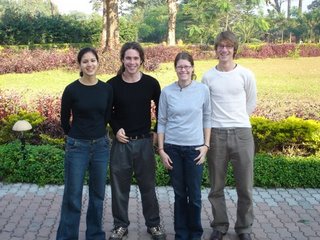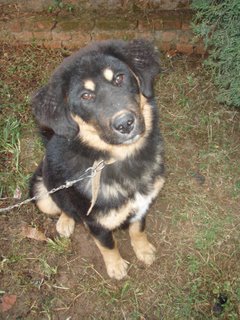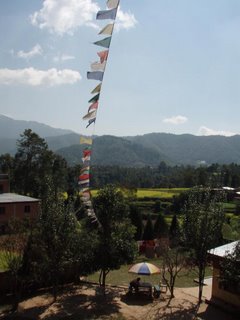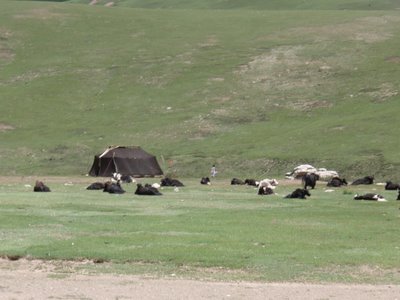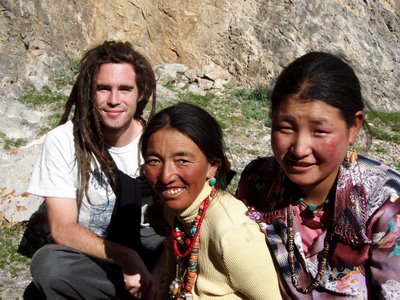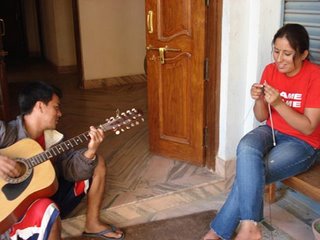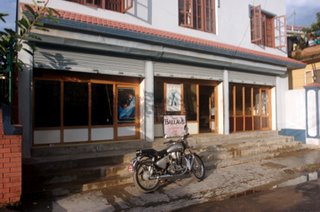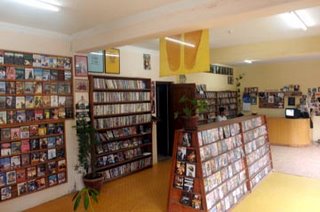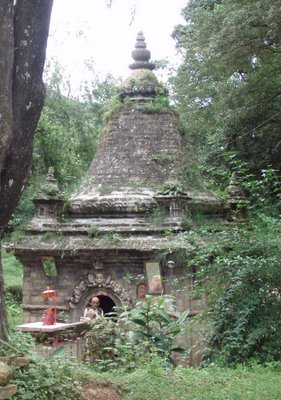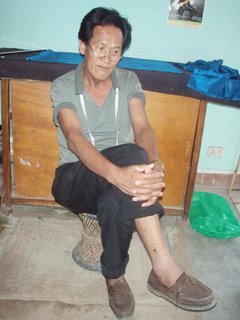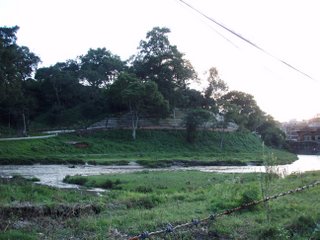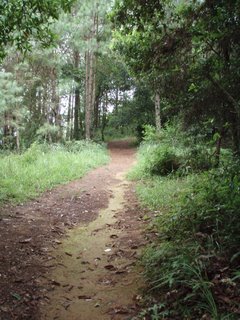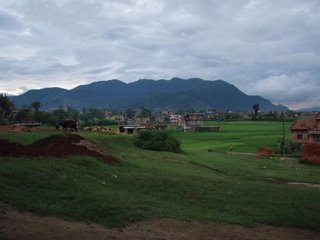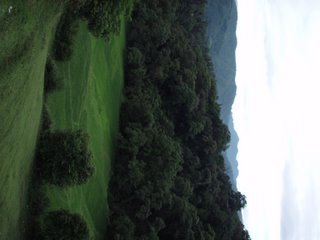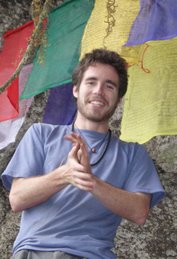What follows is my final report for the Passage Project for International Education's blog, describing our 12 day trip through Tibet during July. I'm now happy back in Kathmandu, working on the book, reading, and making preparations for my India trip next week and my Fulbright study and research program for this year.
As it turns out, the apple pie from Fire and Ice Pizza in Kathmandu should be avoided. “Gentle” Jenny, our west coast dreamer, spent the early morning hours of Saturday August 16, the day of departure on China Air Flight 408 to Lhasa, hugging the toilet of the Passage Project’s Program house for dear life. To my attempt at comfort, “It’s OK, we’ve all been there before,” she gave a pale feeble retort, “I haven’t!” What a trooper, although experiencing the most intense food poisoning of her life, she still made a dignified presence through the Kathmandu Airport, and we were soon in the air. The excitement of the group was obvious, the flight is beautiful, providing a high altitude view of the Chomolangma (Everest) massif.
Unfortunately our scientist, Lisa the geologist/biologist, soon felt ill in a similar way upon landing at the Gongkar airport an hour outside of Lhasa. She had eaten less of the pie, and was able to at least maintain an impressive control over her biological functions, at least until the group was happily checked in at the Kyichu Hotel Lhasa, our base of operations for the week in the ancient capital of Tibet. Afternoon altitude induced naps were on the agenda for the first day in the land of the snows.
Despite this inauspicious beginning to the Tibet segment of the program, this summer’s passage students proved to be comparatively very healthy and remained enthusiastic about the trip despite illness, the harrowing nature of the roads and the packed schedule, which helped me keep up my own excitement, which in turn kept them interested. While traveling, transpersonal interdependent origination of emotion and thought become more obvious.
Sunday was our Lhasa exploration day, and we spent an enjoyable morning in the oldest and most important pilgrimage site in Tibet, the Jokhang Temple, which houses the statue of the young Buddha brought to Lhasa by the Nepali princess Brikuti in the seventh century, announcing the official transmission of Indian Buddhism as the Tibetan state religion. The students also gawked at the ubiquitous Chinese tourist, gawking through cameras at pretty much everything. The railroad arrived in Tibet from mainland China on July 2, and there are many more Chinese pleasure seekers exploring the ancient plateau, as well as many leaving a place where they don’t quite feel welcome.
The students also spent many enjoyable hours walking the Barkhor, an old market that is actually the circumabulation path around the Jokhang, making it a most interesting space for religious practice, trade and socialization. One can experience all aspects of public Tibetan life there, from prostrating pilgrims to intense jovial bargaining, tea and barley beer drinking; almost anything imaginable can be bought if the right price is found.
As this can be intense for the new arrival, we took taxi cabs on that pleasant Sunday afternoon to a new riverside park for a picnic, and the group naturally made quick friends with a Tibetan family happy to share their shade, snacks and butter tea for some fun with sincere foreigners. Often the short time in between the scheduled trips to ancient monasteries and fantastic mountain views can be the most informative and memorable. As Robert Pirsig points out in Zen and the Art of Motorcycle Maintenance, the sides of the mountain often hold more to discover about truth and beauty than the top, to those who are willing to look…
After our merry picnic, we took an evening stroll through the shade lanes around the Norbulingka, the Dalai Lama’s Summer Palace in Western Lhasa. The empty and eerily preserved guest and bedrooms of the Fourteenth Dalai Lama was a precursor to the museum like quality of the Potala Palace tour. Ancient Tibetan and Nepali temples and shrines are often most compelling because they are not a part of dead culture, but rather living monuments of a continuous heritage, not just materially preserved, but preserved in use and meaning.
Monday was our first monastery tour day, rising early to drive out to Ganden, the spectacularly huge ridge-top center of Buddhist learning. The circumambulation path around the monastery provided the students with the stunning scenery they expected on the trip, and was an excellent walking meditation to take in the ruins of a much larger monastery that spread over the mountain before the Cultural Revolution leveled much of the structures.
The car dropped us off at Drepung, the second of the three main Gelukpa (reformed school of Tibetan Buddhism, the former Tibetan Government represented by the Dalai Lama) monasteries we were to visit. After a nice chat with a hermit nun, we followed the main pilgrim path to the debate courtyard, where the students were able to observe the monks participating the in traditional style of dialectical debate; taking the form of excited non-stereotypical battles of wits amongst the monks. Everywhere one looks something can be pointed out as a teaching example of some sort, and the philosophical discussion or contemplation that is spurred by the courtyards are invaluable to me as an educator.
Tuesday was Gelukpa monastery day number two, and we started off in high spirits by taking a tour of the magnificent Potala Palace, the former residence of the Dalai Lamas. Although somewhat disappointed by the regulated nature of the scene (not much time or room to linger, many Chinese tourist on their way through!), it remains as an immense example of practical Tibetan architecture and a poignant example of recent history.
That afternoon we grabbed taxis to Sera monastery, in order to catch a great view of Lhasa and see more monks debating. The cool willow shade and old stone paths stand as a stark contrast to the neo Chinese urban sprawl of Lhasa. It is quite easy to spend hours wandering through different chapels, asking the friendly monks about various aspects of painting or sculpture, ritual and schedule. These are my favorite aspects of the trip.
An early start the next day saw us off into area where imperial Tibetan culture began, the Yarlung Valley, south of the Lhasa Kyichu River. We drove by sand flats and around mountain bends to Samye, the first monastery to be erected in Tibet. The stories of meditation and miracles that surround this area are endless and amazing. A rural gem in the rough landscape, I’m afraid the students were wishing to stay longer as we had only scheduled a day trip.
The next long trip outside of Lhasa brought us to the amazing Sky Lake (Namtso), which happens to be the highest lake in the world, a breathtaking (in more than on way) sapphire set amongst snowy ranges. After a stroll around the holy hills exploring meditation caves and having fun with playful Tibetan pilgrims, the dusk clouds broke for a glimpse of stars beyond imagination.
The final evening and morning back in Lhasa was a time for last minute shopping and enjoying the comfort of the city before departing on the five-day overland trip back to Kathmandu. The students were impressed with the kitchy atmosphere of the Folk Music Bar, showcasing a unique Tibetan Chinese man’s ability at Mongolian throat singing. A fitting farewell to a cosmopolitan and quickly changing city.
As the high pass between Lhasa and Gyantse is impassable due to road construction, we drove directly to Shigatse, the second largest city in Tibet, boasting a huge population of little over 50,000. The afternoon tour of Tashi Lhunpo, the seat of the Panchen Lamas in Shigatse, surprised the students with splendor. Tashi Lhunpo suffered less destruction than typical during the Cultural Revolution, and the three storey statue of the future Buddha defies concepts when it is directly perceived.
The next day we day-tripped to Gyantse, location of the largest stupa (reliquary monument) in Tibet, filled with 100,000 images of buddhas, bodhisattvas and other important deities. There are 147 chapels inside of the monument, mind expanding (or numbing) to examine, although they can be skipped for a spiraling walk to the amazing view of southern Tibet from the top. The levels represent the gradual stages to enlightenment, which is easy to believe when viewing the crisp ridge of the old fort across town, illuminated by the deep azure sky.
Back in Shigatse some of us walked the long pilgrims’ circumambulation path around Tashi Lhunpo into the old Tibetan quarter of town. Excellent examples of life unchanged for many years, smiling faces and growling dogs, battered doors and ancient prayerwheels lead to a market for some fun evening barter. As is often in Asia, we soon emerged into the modern Chinese strip, accentuating the contrast between the ancient and modern, colorful and drab, that which is being created and those things that wither, neglected.
In an attempt to create downtime for hanging around Tingri village, which would be our last night spent in Tibet, we sped through the Tibetan high arid landscape, stopping at Sakya Monastery, the seat of the Sakya school of Tibetan Buddhism and also the center of government in the 13th and 14th Centuries. The immense gray and red structures jut out of the earth impressively. One student remarked to me about the authentic peaceful feeling of the monastery, and I was happy to see that they were not tired of seeing monastery after monastery, but were making the effort to see what is unique, what is not obvious, and to capture something of the energy of these sacred spaces, which we would not stay at long.
We spent that night in New Tingri, and actually had a very pleasant evening sipping tea and beer with our guide’s family in town. It was a perfect experience of a Tibetan social visit, replete with full bladders and loud talk. New Tingri is a few kilometers drive to the smallest monastery we visited the next morning, the Shelkar Chode Gompa (White Crystal Dharma Center), which is an excellent example of a branch political and monastic establishment, totally blasted by the Chinese Red Guards. The huge walls of the destroyed fortress remain, which had previously repelled invasions from Nepali soldiers. It is important to see something of the rural and unspectacular as well.
That evening in Tingri village was meditative, as the students perched on the abandoned fort south of town ready to catch a glimpse of Chomolangma (Everest) peeking through the monsoon clouds. Regardless of whether the climax ever came, peace pervades that sacred valley, and I the students took time to soak up the final evening light they would see in Tibet. We ate at the Namtso Restaurant that night, and had fantastic pizza and banana chocolate crepes for dessert. This was a pleasant surprise, and everyone slept well that night, their consciousness’ mingling with the thin atmosphere for the last time.
The trip back to Nepal was full of anticipation, and feelings were as volatile as the scenery, which changed from high mountain pass to desert slopes, finally into drastic gorges filled with vegetation, and deep misty canyons into Nepal. Everyone was elated (oxygen intoxication) when we made it to the Last Resort, a gem of luxury in the foothills of the high Himalaya, where we rested and recuperated before returning to the chaos and excitement of Kathmandu.
The trip schedule was very busy, as there is always something more to see, hear or examine, and only over the next few months will the students be able to make more sense of what they experienced. One thing is for certain. They will now feel compelled to take off to new and unknown locations on a whim, more confident in their ability to travel, and to learn from the unexpected, without fear.
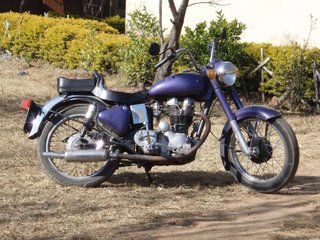
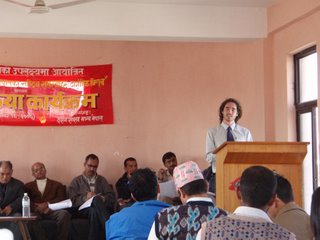
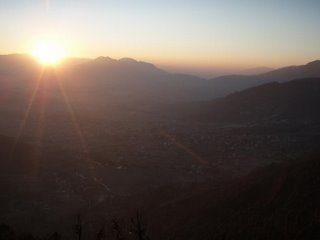
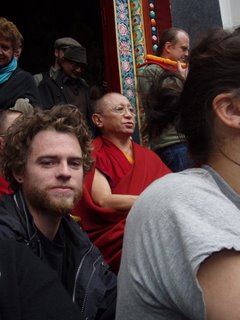 Chris with the venerable Chokyi Nyima Rinpoche, posing for a group photo after the 2006 Seminar on Vajrayana Buddhist Meditation at the White Monastery.
Chris with the venerable Chokyi Nyima Rinpoche, posing for a group photo after the 2006 Seminar on Vajrayana Buddhist Meditation at the White Monastery.

